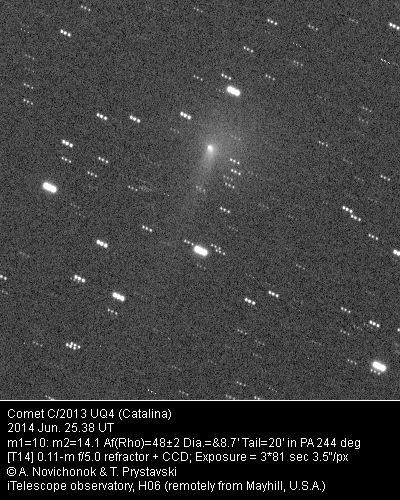Comet C/2013 UQ4 (Catalina)
Damocloid 2013 UQ4 was discovered on October, 23rd, 2013 by Catalina Sky Survey (68-cm f/1.7 Schmidt telescope equipped with CCD camera) at magnitude of about 18.5. During first few months there was no cometary activity observed (while according to MPC absolute magnitude H=12.9m indicating that diameter of object is 7-20 km (if assuming typical comet nucleus albedo of 0.04, then diameter of object is actually 17.5 km) i.e. object is quite large, if we supposed no cometary activity at all. Starting late January, 2014 no further observations of the asteroid-like object were possible due to conjunction with the Sun (at 18 mag).
Cometary activity of 2013 UQ4 was discovered in early May, 2014. On May, 7th, 2014 the observations of object were carried out by A. Novichonok and T. Prystavski using a 50-cm remote telescope (MPC=Q62, iTelescope observatory. Siding Spring, Australia) when object was low in the morning sky (at an altitude of a little more than 20°). Comet looked relatively large and diffuse with a total magnitude of about 13.5m. External very diffuse coma diameter was 1.5’, but the inner compact and well condensed coma was of 25'' arc. Photometric nucleus and surrounding condensed coma were located asymmetrically within the outer coma of the comet. Soon comet was given designation C/2013 UQ4 (Catalina).
During the next lunation, when the comet was still low in the morning sky, first visual observations were carried out. On June, 6.43, Alan Hale observed C/2013 UQ4 using a 41-cm reflector (m1=11.9, Dia.=0.9', DC~3). Despite the zodiacal light and low altitude, it was easy to see the comet. According to Alan Hale due to these unfavorable conditions, the total magnitude could be slightly underestimated.
CCD observations carried out by A. Novichonok and T. Prystavski using a 0.11m f/5.0 refractor (iTelescope observatory. Siding Spring, Australia) revealed a significant increase in brightness over the last month. While keeping its asymmetry, comet’s coma increased up to 3.2’ and total magnitude attained 11.5m (images were obtained using Luminance filter, R comparison stars). As a month ago, there’s a presence of brighter inner coma and diffuse external coma, but the differences are not so striking, and not so definite boundary between the external and inner coma observed. Rob Kaufman (Australia) on the 5th of June obtained image of the comet with DSLR-Canon 650D camera and a 200-mm telescope, stating that external coma size was possibly up to 5'.
Mid-June images of the comet revealed fairly well-defined long ion tail in addition to very diffuse coma visible.
***
Orbital elements:
Epoch 2014 May 23.0 TT = JDT 2456800.5
T 2014 July 5.9587 TT MPC q 1.080971 (2000.0) P Q z +0.016516 Peri. 23.3119 +0.4598277 -0.8007782 T = 2456844.45874 JDT +/-0.000001 Node 317.6621 -0.8777269 -0.4754376 q = 1.0809706 e 0.982147 Incl. 145.2583 -0.1347367 +0.3642986 Earth MOID = 0.10556 AU
1/a(orig) = +0.017203 AU**-1, 1/a(fut) = +0.017105 AU**-1.

